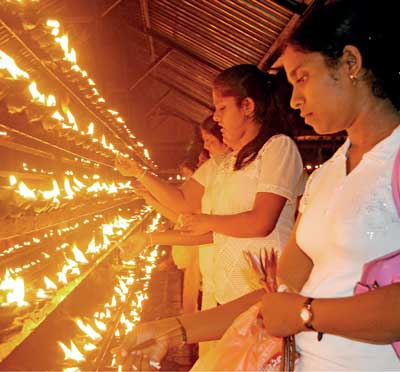Saturday Jan 17, 2026
Saturday Jan 17, 2026
Saturday, 6 May 2017 00:01 - - {{hitsCtrl.values.hits}}
On the full moon day of May in the year 623 BC, there was born in the district of Nepal an Indian Sakya prince named Siddhartha Gotama, who was destined to be the greatest religious teacher in the world. Brought up in the lap of luxury, receiving an education befitting a prince, he married and had a son.
His contemplative nature and boundless compassion did not permit him to enjoy the fleeting material pleasures of a royal household. He knew no woe, but he felt a deep pity for sorrowing humanity. Amidst comfort and prosperity, he realised the universality of sorrow. The palace, with all its worldly amusements, was no longer a congenial place for the compassionate prince. The time was ripe for him to depart. Realising the vanity of sensual enjoyments, in his twenty-ninth year, he renounced all worldly pleasures and donning the simple yellow garb of an ascetic, alone, penniless, wandered forth in search of Truth and Peace.
– Ven Narada,
‘Buddhism in a Nutshell’
By D.C. Ranatunga
Of the 12 Full Moon Poya Days in the year, Vesak Poya in May is the holiest day for the Buddhists. The day commemorating the Birth, Enlightenment and Passing away of the Buddha is celebrated by the Buddhists the world over.
Even the humblest of homes throughout Sri Lanka will have the six-coloured Buddhist flag hoisted in their homes. From dawn on Vesak Poya day, temples will be full of devotees of all ages clad in simple white clothes, where they will observe Ata Sil – Eight Precepts. As a monk narrates each precept, the devotee repeats it pledging to observe them throughout the day. They are repeated in the evening until next morning when they take Pan Sil – Five Precepts to conclude.
During the day the devotees offer flowers, partake in ‘Buddha pooja’ – offering of meals in the morning and lunch time before the image of the Buddha in the ‘Budu ge’ (image house), in between listening to sermons by monks, and meditating. Most adults spend the night in the temple where they will meditate, have Dhamma discussions or chant ‘pirith’ till late into the night.
The solemnity obseraved at the temple during the day turns into a blaze of light in the night. ‘Pol thel pahan’ – small clay lamps filled with coconut oil and lit with home-made wicks, are kept round the Bo-tree as a mark of respect to the location where Prince Siddhartha attained Enlightenment. Lamps are also lit and placed on shelves made in specified places for the purpose.
Family members who return home on the evening will light oil lamps and display them at the entrance to the house. Vesak ‘koodu’ – paper lanterns are lit with candles and hung on trees. Days ahead of Vesak, young ones make their own lanterns to be lit on Vesak night. Lighting of lamps and lanterns, referred to as ‘aloka pooja’, symbolises the dispelling of darkness.
Specially-designed Vesak lanterns in varying sizes and shapes adorn the streets.
Vesak songs are heard over loudspeakers near ‘thoranas’ – pandals erected in the towns away from the temple. Artists use pandals to pay homage to the Buddha by portraying his virtuous life and relating his past births described in Jataka stories. The story depicted in the pandal is related in dialogue form through loudspeakers. Both the colourful paintings and the myriads of bulbs changing colour every now and then, enthral the crowds who gather in large numbers to see the pandals.
Word gets round where the most beautiful pandals are and crowds flock to see them over a number of days following the Vesak Poya. Most of them are in Colombo and it becomes a good outing for people to come to see them.
‘Dansalas’ form part and parcel of Vesak celebrations. Enthusiastic youngsters put up ‘dansalas’ offering free food and beverages to passers-by. They collect funds from businessmen and individuals weeks ahead and plan the whole operation.
Temporary sheds are put up at strategic locations along main roads where people walk to see Vesak pandals and other decorations. The sheds are well decorated, a number of tables are kept inside forming a long table where food (mainly rice and curry) is served with chairs to sit and have a meal comfortably. Music is played for the whole neighbourhood to hear.
While some are busy arranging the food, others are on the road to stop those who travel in vehicles and offer soft drinks. They also lead those who walk into the ‘dansala’ and it’s not easy to avoid them and walk even though motorists can drive away without stopping.
Today the ‘dansalas’ range from ‘noodles dansal’ to ‘ice cream dansal’!
Live concerts have also become a feature for Vesak in street corners where there is space for people to gather and watch. Popular Vesak songs are sung and short dramas are enacted. Puppet shows are also a popular form of entertainment during the Vesak season.
Vesak is thus is a mix of solemnity, festival of lights and acts of generosity.